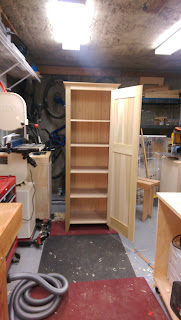All of the lumber for the case and door frame is from one board. That board was part of a batch of lumber I bought last summer from a guy who was retiring. The board was about 11" wide and had been thicknesses to 3/4". It has a bit of a cup to it so I decided it would work well for this cabinet as i didn't want the case to be a full 3/4" thick.
I was able to get all the case parts and the shelf from that one piece. The rails and stiles for the door were from the offcuts of the corresponding case pieces. This let me utilize nearly the entire board and ensured a good grain and color match for the door.
After processing the stock for the case, I laid out and cut the dovetails for the corners. Because the top and bottom overhung the sides I decided to go with half tails on the ends. For transferring the tail to the pin board I tried out Chris Schwarz's "
Dovetail Ruler Trick". Tacking a wooden ruler on would be even better, but clamping a metal ruler certainly helped.
With the case complete, I cut dados in the sides for the shelf. I ended up cutting them by hand for the practice and because I didn't feel like taking the route out of the table. This operation was certainly one of those times where trying to use the router may have taken longer by the time I got it set up. The groove for the back panel was cut at the router table as I hadn't received this yet.
Having spent some time trying to get an old Stanley #55 to work well, this tool is a welcome change.
Next up was to finish the door panel. I had decided to finish this project with General Finished EnduroVar and it went on really nicely. This finish has all the good characteristics of a water borne finish, easy clean up, dries fast, and doesn't smell terrible while also having the nice warm color of a oil varnish. I found that cheap foam brushes were the best way to apply this, though I suspect it will spray nicely when the weather is warm enough to finish outside.
I lightly sanded between coats with 220 to smooth things out, and then finished the final coat with 3M scotchbrite pads. I found that they stick pretty well onto the ROS which makes bringing the entire panel up to an even sheen a piece of cake.
The door frame was pretty straightforward, grooves on the router table for the panel and dominos for the joints. Old Brown Glue to stick it all together.
To protect the panel I covered it with painters tape. Then it was time to sand the frame smooth and move onto hardware installation.
As I was using knife hinges, I had to to cut the mortises for them before I glued up the case. When it came time to glue up the case I installed the door to make sure everything lined up.
And the final product, installed and serving admirably. It is hung with a French cleat. I offset the back panel 3/8" in to allow for the thicker french cleat. The fixed portion of the cleat is glued directly onto the plywood back and the top. The wall mounted cleat was attached to the wall with 3 Wall dog screws, one of which is into a stud so it should hold up to a full load of the good stuff.
I've got better pictures of the finished piece
here.





















































